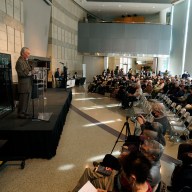More and more North Americans are working from home, whether that means plopping a laptop on the dining room table or having a room dedicated as an office.
Phones and computers aside, virtually any space can be made into a workable home office by concentrating on a few basic ingredients: A chair, a desk, lighting and storage. Some quick tips from designers on what to look for:
The chair
Hands down, this is the most important item, designers say.
“It should probably be your biggest investment,” says Peggy Kovacic of Burbank, Calif., an IKEA designer for nearly a decade. “Investing in a chair today, your back will thank you tomorrow.”
Greg Dunlop, a national manager for Boston-based Allsteel, which makes office furniture, says a top-notch office chair will: Support your back by following the curve of your spine, have an adjustable seat pan that slides forward and back, can be adjusted higher or lower and, if possible, have adjustable arm rests.
A designer himself, Dunlop advocates for his company’s Acuity chair, which is similar in price (and appearance) to the iconic Aeron chair, which has been the gold-star standard for office chairs for years. The Acuity retails for $600 to $800 US.
Dunlop warns against office chairs that place a bar at the lower back to lend support.
“That’s not what you want,” he says. “That’s another pressure point.”
Monica Pedersen, an HGTV designer, likes IKEA and Crate & Barrel’s office chairs. In particular, she recommends Crate & Barrel’s Icon Executive office chair ($599 US) and IKEA’s Nominell swivel chair (starting at $139 US) for bringing style into the home office.
IKEA’s Kovacic warns against buying a chair online.
“You want to sit in it and make sure your body feels good in it,” she says.
The desk
Dunlop cautions that while most office desks are 76 to 81 centimetres tall, if you buy one that’s taller, make sure your chair will adjust. If it doesn’t, you may be able to resolve the difference by attaching a keyboard tray to the underside of the desk.
The key is to avoid having your shoulders raised while typing at the computer, says Dunlop.
If the desk and chair don’t align properly, your elbows won’t make that ergonomic, 90-degree angle that helps prevent back pain.
As for desk style, Pedersen often uses Ballard Design’s modular office furniture in her design projects because they’re attractive and “you can create it any way you want.”
Lighting
Pedersen recommends a swing-arm lamp on the wall above the desk for task lighting and either a larger lamp or good ceiling lighting for more diffused light.
Kovacic advocates a swing arm with a halogen bulb and trying to position the desk near natural light.
“You’re sitting inside all day, so natural light makes it so much nicer,” she says.
Storage
Kovacic recommends something with doors that close to minimize clutter, especially if the work area is in a prominent part of the house, such as a family room. Homeowners can tuck away not just files and accessories, but computers and printers behind cabinet doors, too.
“It makes it look more serene and clean,” says Kovacic.
















